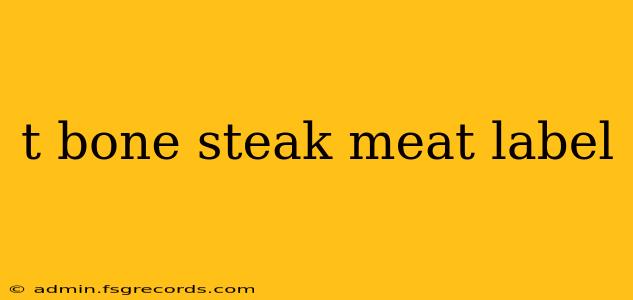Choosing the perfect T-bone steak can feel like navigating a minefield of labels and jargon. Understanding what those labels mean is key to ensuring you get the delicious, high-quality cut you crave. This guide breaks down everything you need to know about T-bone steak meat labels, empowering you to make informed choices at the butcher counter or grocery store.
Understanding the Basics: Cuts and Grades
Before diving into specific labels, let's establish a foundational understanding of what makes a T-bone steak a T-bone steak.
The Cut:
A T-bone steak gets its name from the distinctive T-shaped bone that separates the tenderloin (a smaller, more tender cut) from the top loin (a larger, slightly less tender cut). This unique bone structure is what gives the steak its characteristic flavor and texture. The size and shape of the bone can vary slightly depending on the animal and the butchering techniques used.
The Grades:
In the United States, beef is graded by the USDA (United States Department of Agriculture) based on factors like marbling (the intramuscular fat), maturity (the age of the animal), and firmness of the meat. The most common grades you'll encounter are:
- Prime: This is the highest grade, characterized by abundant marbling, resulting in exceptional flavor and tenderness. Prime beef is often found in high-end steakhouses but can sometimes be found in select grocery stores.
- Choice: This grade offers a good balance of flavor and tenderness, with less marbling than Prime. It's a popular choice for home cooks and is widely available.
- Select: This grade is leaner than Choice and Prime, resulting in a less tender and flavorful steak. It's a more economical option but may require longer cooking times.
Other grades exist (e.g., Standard and Commercial), but they are less commonly found in retail settings.
Deciphering the Meat Label: What to Look For
Now, let's break down the information typically found on a T-bone steak label:
1. USDA Grade:
As discussed above, look for the USDA grade (Prime, Choice, or Select). This is a crucial indicator of quality and flavor.
2. Cut Information:
The label should clearly state "T-Bone Steak." Sometimes, you might see additional information specifying the weight or thickness of the steak.
3. Packaging Date:
This helps you determine the freshness of the meat. Choose steaks with a recent packaging date for optimal quality.
4. Country of Origin:
Knowing where the beef originates can be helpful for traceability and ensuring compliance with any personal preferences or dietary restrictions.
5. Additional Information:
Some labels might include details about how the animal was raised (e.g., grass-fed, grain-fed), which can impact the flavor and nutritional profile of the steak. Other labels might indicate whether the steak has been treated with any preservatives or additives.
Beyond the Label: Tips for Choosing a Great T-Bone Steak
Even with a well-labeled steak, there are additional factors to consider:
- Look for good marbling: Even within a grade, marbling can vary. Look for steaks with a good distribution of intramuscular fat throughout the meat.
- Check the color: The beef should be a bright red color. Avoid steaks that appear brown or dull.
- Feel the texture: The meat should feel firm and springy to the touch.
By understanding the information on the meat label and considering these additional factors, you can confidently select a T-bone steak that meets your expectations for quality, flavor, and tenderness. Enjoy your perfectly cooked steak!

